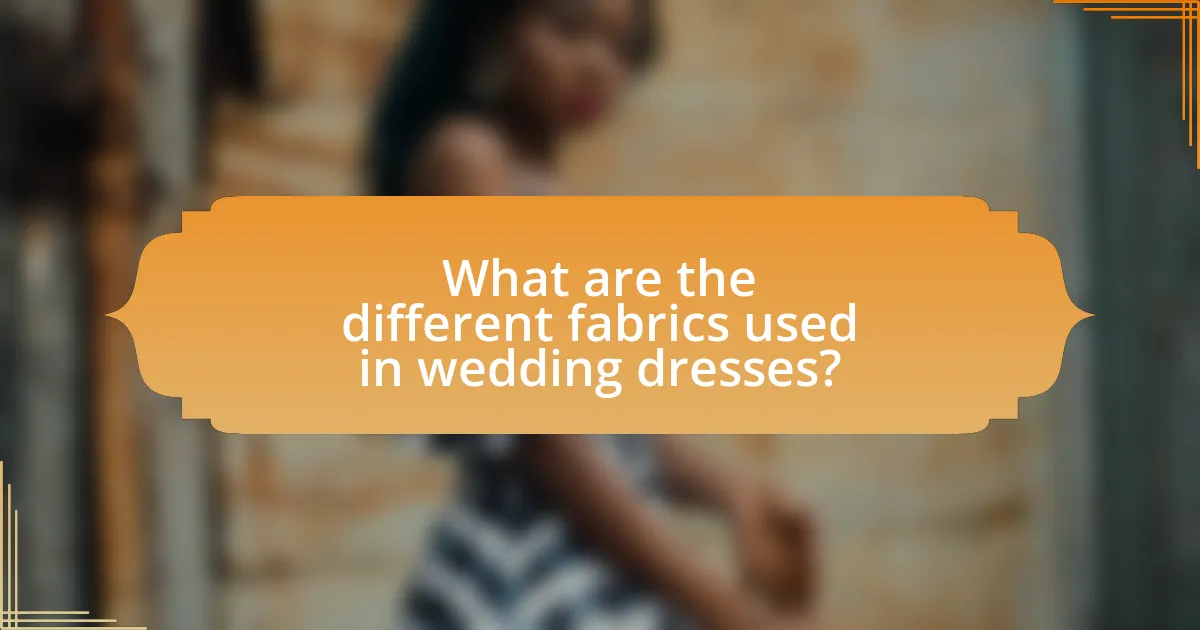The article focuses on the care and maintenance of various fabrics used in wedding dresses, including satin, lace, tulle, chiffon, organza, and silk. It outlines how fabric choices impact the dress’s overall look, silhouette, and comfort, while also addressing factors such as climate, personal style, and durability. Additionally, the article provides specific care tips for delicate fabrics like silk and lace, as well as more durable options like polyester and satin, ensuring that brides can preserve the beauty and integrity of their wedding attire. Common troubleshooting tips for unexpected stains and shrinkage are also discussed, offering practical solutions for maintaining wedding dresses.

What are the different fabrics used in wedding dresses?
The different fabrics used in wedding dresses include satin, lace, tulle, chiffon, organza, and silk. Satin is a popular choice for its luxurious feel and smooth finish, while lace adds intricate detailing and texture. Tulle is often used for skirts and veils due to its lightweight and airy quality. Chiffon offers a soft drape and flow, making it ideal for romantic styles. Organza is a stiffer fabric that provides structure, and silk is renowned for its elegance and natural sheen. Each fabric has unique properties that influence the overall look and feel of the wedding dress.
How do fabric choices impact the overall look of a wedding dress?
Fabric choices significantly impact the overall look of a wedding dress by influencing its silhouette, texture, and drape. For instance, silk creates a luxurious and flowing appearance, while lace adds intricate detail and a romantic feel. Additionally, heavier fabrics like satin provide structure and formality, whereas lighter materials such as chiffon offer a more ethereal and soft look. The choice of fabric also affects how the dress interacts with light; for example, satin reflects light beautifully, enhancing the dress’s elegance, while matte fabrics can create a more understated aesthetic. These variations in fabric not only define the visual appeal but also contribute to the overall style and theme of the wedding.
What are the most popular fabrics for wedding dresses?
The most popular fabrics for wedding dresses include satin, lace, chiffon, tulle, and organza. Satin is favored for its luxurious feel and elegant drape, while lace adds intricate detailing and a romantic touch. Chiffon is lightweight and flowy, making it ideal for soft silhouettes. Tulle is often used for voluminous skirts and veils due to its sheer quality, and organza provides a crisp, structured look. These fabrics are commonly chosen for their aesthetic appeal and versatility in design, making them staples in bridal fashion.
How does the fabric type influence the dress’s silhouette?
The fabric type significantly influences a dress’s silhouette by determining its structure, drape, and overall shape. For instance, heavier fabrics like satin and taffeta create a more structured silhouette, allowing for defined shapes such as ball gowns, while lighter fabrics like chiffon and organza provide a softer, flowing silhouette that enhances movement and creates an ethereal look. The choice of fabric directly affects how the dress falls on the body, with stiffer materials holding their shape and softer materials draping more fluidly. This relationship between fabric and silhouette is crucial in wedding dress design, as it impacts both aesthetic appeal and comfort for the wearer.
What factors should be considered when selecting fabric for a wedding dress?
When selecting fabric for a wedding dress, factors such as drape, comfort, durability, and care requirements must be considered. Drape affects how the fabric falls and shapes the dress, influencing the overall silhouette. Comfort is crucial, as the bride will wear the dress for an extended period; breathable fabrics like cotton or silk are often preferred. Durability ensures the dress withstands wear and movement throughout the event, with materials like satin or taffeta being popular choices. Lastly, care requirements dictate how easy it is to clean and maintain the fabric, with some materials requiring special handling to preserve their appearance.
How do climate and season affect fabric choice?
Climate and season significantly influence fabric choice for wedding dresses. In warmer climates or during summer, lightweight and breathable fabrics such as chiffon, organza, and cotton are preferred to ensure comfort and prevent overheating. Conversely, in colder climates or during winter, heavier fabrics like satin, velvet, and taffeta are chosen for their warmth and structure. This selection is supported by the fact that natural fibers like cotton and linen wick moisture away, making them ideal for hot weather, while synthetic fibers like polyester provide insulation in cooler temperatures.
What role does personal style play in fabric selection?
Personal style significantly influences fabric selection by determining the aesthetic and functional preferences of the individual. For instance, someone with a romantic style may opt for soft, flowing fabrics like chiffon or lace, while a modern minimalist might prefer structured materials such as satin or crepe. This alignment between personal style and fabric choice ensures that the final garment reflects the wearer’s identity and comfort, enhancing their overall experience. Studies in fashion psychology indicate that personal style not only affects choices in clothing but also impacts emotional well-being, reinforcing the importance of selecting fabrics that resonate with one’s unique style.

How to care for delicate fabrics in wedding dresses?
To care for delicate fabrics in wedding dresses, gently hand wash or use a delicate cycle in cold water with a mild detergent. Delicate fabrics, such as silk or lace, can be easily damaged by harsh chemicals and high temperatures, so it is essential to avoid bleach and hot water. Additionally, air drying is recommended to prevent shrinkage and maintain the fabric’s integrity, as heat from dryers can cause delicate materials to warp or lose their shape.
What are the best practices for cleaning silk wedding dresses?
The best practices for cleaning silk wedding dresses include dry cleaning, spot cleaning, and gentle hand washing. Dry cleaning is recommended because it effectively removes stains without damaging the delicate fibers of silk. Spot cleaning should be done immediately with a mild detergent and cold water to prevent stains from setting. If hand washing is necessary, use lukewarm water and a gentle silk-specific detergent, ensuring to avoid wringing or twisting the fabric to maintain its integrity. These methods are validated by textile care experts who emphasize the importance of treating silk with care to preserve its texture and appearance.
How can you remove stains from silk without damaging it?
To remove stains from silk without damaging it, gently blot the stain with a clean, dry cloth to absorb excess liquid. Following this, mix a solution of lukewarm water and a few drops of mild detergent specifically designed for delicate fabrics. Use a soft cloth or sponge to apply the solution to the stained area, working from the outside of the stain inward to prevent spreading. Rinse the area with a damp cloth to remove any detergent residue, and then allow the silk to air dry away from direct sunlight. This method is effective because silk is sensitive to harsh chemicals and high temperatures, which can cause damage or discoloration.
What are the recommended washing methods for silk?
The recommended washing methods for silk include hand washing in cold water with a gentle detergent or dry cleaning. Hand washing is preferred as it minimizes damage; silk is delicate and can be easily harmed by agitation. When hand washing, immerse the silk item in cold water, gently agitate, and rinse thoroughly without wringing. Dry cleaning is advisable for intricate silk garments, as professional services ensure proper care without risking fabric integrity. These methods are supported by textile care guidelines, which emphasize the importance of gentle handling to maintain silk’s luster and texture.
How should lace wedding dresses be maintained?
Lace wedding dresses should be maintained by gently hand-washing them in cold water with a mild detergent. This method prevents damage to the delicate lace fibers, which can be easily frayed or discolored by harsh chemicals. After washing, it is essential to lay the dress flat on a clean, dry towel to air dry, avoiding direct sunlight to prevent fading. Storing the dress in a breathable garment bag, away from moisture and direct light, will help preserve its condition. Regular inspections for any signs of wear or stains should also be conducted to address issues promptly, ensuring the lace remains in pristine condition for future use.
What cleaning solutions are safe for lace fabrics?
Cleaning solutions that are safe for lace fabrics include mild detergents specifically formulated for delicate fabrics, such as those labeled as “gentle” or “delicate wash.” These detergents help maintain the integrity of the lace without causing damage. Additionally, using a solution of cold water mixed with a small amount of white vinegar can effectively clean lace while preserving its texture and color. It is essential to avoid bleach and harsh chemicals, as they can weaken the fibers and lead to discoloration.
How can you prevent lace from fraying or tearing?
To prevent lace from fraying or tearing, apply a fabric sealant or fray check to the edges of the lace. This product creates a protective barrier that helps to secure the fibers and prevent unraveling. Additionally, handling lace gently and avoiding excessive pulling or stretching during wear and cleaning can further reduce the risk of damage. Studies show that using a sealant can significantly extend the lifespan of delicate fabrics, making it a practical solution for maintaining lace integrity in wedding dresses.

What are the care tips for more durable fabrics in wedding dresses?
To ensure the longevity of more durable fabrics in wedding dresses, it is essential to follow specific care tips. First, always check the care label for manufacturer instructions, as they provide the best guidance for cleaning and maintenance. For fabrics like polyester or satin, gentle hand washing in cold water with mild detergent is recommended, as this helps preserve the fabric’s integrity. Additionally, avoid using bleach or harsh chemicals, which can damage the fibers.
When drying, air drying is preferable; hang the dress in a shaded area to prevent fading from sunlight. If ironing is necessary, use a low heat setting and place a cloth between the iron and the fabric to avoid direct contact, which can scorch or damage the material. Storing the dress in a breathable garment bag, away from direct sunlight and moisture, will also help maintain its condition over time. These practices are supported by textile care guidelines that emphasize the importance of gentle handling and appropriate storage for durable fabrics.
How do you care for polyester wedding dresses?
To care for polyester wedding dresses, gently hand wash the garment in cold water using a mild detergent. Polyester is a durable fabric that can withstand gentle cleaning methods, and hand washing helps prevent damage. After washing, lay the dress flat on a clean towel to air dry, avoiding direct sunlight which can fade the fabric. If necessary, use a low heat setting on an iron to remove wrinkles, as polyester can be sensitive to high temperatures. These methods ensure the longevity and appearance of polyester wedding dresses.
What washing techniques are suitable for polyester?
Washing techniques suitable for polyester include machine washing on a gentle cycle, hand washing in cold water, and using mild detergents. Polyester is a synthetic fabric that is durable and resistant to shrinking and stretching, making it suitable for these washing methods. Machine washing should be done with cold water to prevent damage, while hand washing allows for more control over the cleaning process. Mild detergents help maintain the fabric’s integrity and color. These techniques are recommended by textile experts and are commonly used in the care of polyester garments, including wedding dresses.
How can you remove wrinkles from polyester effectively?
To effectively remove wrinkles from polyester, use a steam iron or a garment steamer on a low heat setting. Polyester is sensitive to high temperatures, so it is essential to keep the iron or steamer at a safe distance from the fabric to avoid damage. Additionally, placing a damp cloth between the iron and the polyester can help prevent scorching while allowing steam to penetrate the fabric, effectively relaxing the fibers and removing wrinkles. This method is supported by the fact that steam is a common technique used in garment care to eliminate wrinkles without harming the fabric.
What maintenance is required for satin wedding dresses?
Satin wedding dresses require careful maintenance to preserve their appearance and fabric integrity. Regularly spot clean any stains with a mild detergent and a soft cloth, as satin is sensitive to harsh chemicals. For deeper cleaning, professional dry cleaning is recommended, as it helps maintain the fabric’s sheen and structure without damaging it. Additionally, satin should be stored in a cool, dry place, ideally in a breathable garment bag to prevent moisture buildup and dust accumulation. These practices ensure the longevity and beauty of satin wedding dresses.
How can you clean satin without causing damage?
To clean satin without causing damage, gently hand wash the fabric in cold water using a mild detergent specifically designed for delicate fabrics. Satin is sensitive to heat and agitation, so avoid wringing or twisting the material. Instead, lay the satin flat on a clean, dry towel to absorb excess water, then air dry away from direct sunlight. This method preserves the fabric’s sheen and prevents distortion.
What are the best ways to store satin wedding dresses?
The best ways to store satin wedding dresses include using a breathable garment bag, avoiding plastic covers, and storing the dress in a cool, dry place. Satin is sensitive to moisture and light, which can cause discoloration and damage. A breathable garment bag allows air circulation while protecting the fabric from dust and dirt. Additionally, hanging the dress on a padded hanger prevents creasing and maintains its shape. It is also advisable to avoid folding the dress, as this can create permanent creases in the satin.
What are some common troubleshooting tips for wedding dress fabric care?
Common troubleshooting tips for wedding dress fabric care include checking the care label for specific washing instructions, using a gentle detergent suitable for delicate fabrics, and testing any stain removal method on a hidden area first. Additionally, for silk or satin fabrics, avoid direct sunlight to prevent fading, and for lace, hand washing is often recommended to maintain its integrity. These practices help preserve the quality and appearance of the dress, ensuring it remains in excellent condition for the wedding day.
How can you deal with unexpected stains on wedding dress fabrics?
To deal with unexpected stains on wedding dress fabrics, immediately blot the stain with a clean, dry cloth to absorb excess liquid without rubbing, which can spread the stain. Different fabrics require specific treatments; for example, silk can be treated with a mixture of mild soap and water, while polyester may respond well to a gentle stain remover. It is crucial to test any cleaning solution on an inconspicuous area first to avoid damage. According to the Wedding Dress Preservation Kit, prompt action and appropriate cleaning methods can significantly improve the chances of stain removal without harming the fabric.
What should you do if your wedding dress fabric shrinks after washing?
If your wedding dress fabric shrinks after washing, you should first assess the extent of the shrinkage. If the dress is only slightly smaller, you can try gently steaming it to relax the fibers, which may help restore some of its original size. For more significant shrinkage, consider taking the dress to a professional tailor who specializes in wedding attire, as they can make adjustments or alterations to ensure a proper fit. It’s important to note that certain fabrics, like silk or lace, may be more prone to shrinkage, so always follow the care instructions provided by the manufacturer to minimize this risk.



